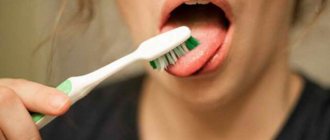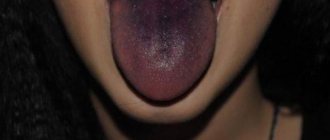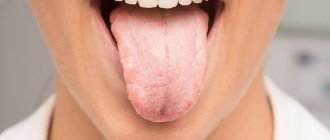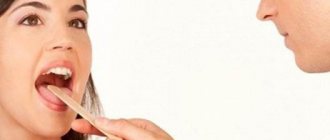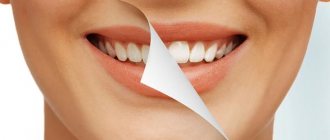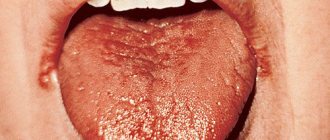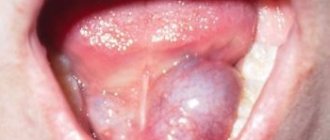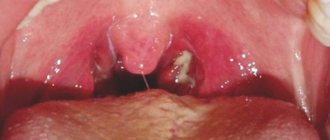Hairy leukoplakia of the tongue is a serious disease of the oral mucosa that occurs in people with weakened immune systems and has severe symptoms. Treatment of the disease and a favorable prognosis directly depend on the reasons for which it appeared. The most severe form of pathology is its occurrence in combination with HIV infection - to avoid the development of Burkitt's lymphoma, chemotherapy or radiation therapy is indicated. Preventive measures help prevent leukoplakia.
Concept of hairy leukoplakia of the tongue
Hairy (hairy) leukoplakia is a disease of the oral mucosa that appears against a background of weakened immunity. It is caused by human herpesvirus type 4 (Epstein-Barr) and in most cases develops in patients with HIV, as well as in people who have undergone surgery or have undergone an internal organ transplant and are taking immunosuppressive drugs. The disease got its name because of its pronounced symptoms: the affected areas of the mucous membrane are covered with small white villi, so the inner surface of the cheeks and tongue look like a fleecy carpet.
The disease can occur in 3 forms:
- simple: flat whitish spots that cannot be cleaned off,
- verrucous: warts or plaques appear on the surface of the mucous membrane on previously formed flat spots,
- erosive: ulcers appear on the surface of the pathological focus that can develop into malignant formations.
The disease was first discovered in 1984 in a patient with HIV and Epstein-Barr virus. The disease most often develops in older people, but children and older people are also not immune from its occurrence.
Definition
Black hairy tongue, or glossifotia , is a disease with a pronounced change in the structure of the surface of the tongue. Inflammation begins with keratinization of soft tissue cells, which leads to active proliferation and elongation of filiform papillae.
Gradually they take the shape of a hair, increasing in diameter to 2 mm. On average, with their hyperplasia, the length of each papilla can increase to 2 cm or more. During the process of active growth, the surface of the papillae becomes keratinized and changes color from straw to brown or black.
By the shade of the hairs, you can determine the degree of neglect of this pathology. Basically, the affected area is localized in the middle or root part of the tongue.
As a rule, the disease develops slowly and unnoticed. The main symptoms appear only in the active phase of development of the pathology.
Often glossifotia temporarily regresses in the initial stages of its manifestation, which often misleads people into thinking about a complete recovery.
This pathology equally affects both adults and children . The most common cases of the disease occur in older men.
The duration of the pathology is about 2 weeks , but in isolated cases a longer period was observed.
Causes
The reason for the development of hairy leukoplakia of the tongue is the presence of the Epstein-Barr virus in the body, the active replication of which begins due to a weakened immune system (we recommend reading: hairy tongue with a coating: causes and treatment).
Factors influencing the appearance and spread of the disease are:
- HIV or AIDS,
- systematic smoking,
- tongue cancer (we recommend reading: what are the stages and symptoms of tongue cancer?),
- acute leukemia,
- constant exposure to ultraviolet rays on the patient’s mouth and lips,
- irritation of soft tissues in the mouth due to crooked teeth, crowns and bridges, braces or incorrectly installed dentures,
- systemic autoimmune pathologies (rheumatoid arthritis, etc.),
- taking immunosuppressive medications.
Provoking factors
The disease has been known for a long time. The first description of the disease was given in 1835, but during this time it was not possible to name the exact causes of the pathology. It is known that black hairy tongue is a consequence of metabolic disorders and the activity of pathogenic microorganisms. But in each specific case, the reasons vary, despite similar clinical manifestations.
The main provoking factors include:
- bad habits - tongue damage is especially common in smokers. Nicotine and combustion products cause increased sensitivity of the tongue to external influences. Alcohol and drugs, which provoke changes in the composition of saliva, negatively affect the condition of the oral mucosa;
- long-term use of antibiotics - destroys the natural microflora, undermines the immune system, increases the vulnerability of the oral mucosa;
- improper oral hygiene - the condition of the tongue is adversely affected by both poor-quality cleansing and abuse of mouthwashes. In the first case, there is an active proliferation of pathogenic microflora, in the second, the acidity of saliva changes;
- gastrointestinal pathologies - a black hairy tongue often accompanies diseases such as ulcerative colitis, gastritis, etc.
Symptoms
The most common signs of hairy leukoplakia are:
- During laboratory tests, the patient is diagnosed with the Epstein-Barr virus or HIV,
- white areas with small villi form on the tongue, palate and mucous membrane of the inside of the cheeks (can be seen in the photo),
- the presence of affected lesions similar to transparent or white warts measuring no more than 1 cm in length,
- the surface of the mucous membrane is heterogeneous, covered with small grooves and “islands”,
- the appearance of cracks and erosions on the tongue, palate and buccal mucosa,
- absence of pain, including when palpating the affected area,
- sensitivity to temperature changes and spicy or sour foods,
- inability to clean off whitish plaque with a toothbrush or a special spatula,
- tickling, cough, difficulty breathing (in the later stages of the disease).
Symptoms of glossophytia
This problem has an official name - glossophytia. And it most often proceeds in accordance with the following stages:
- The filiform papillae grow. This may not be noticeable to the naked eye;
- The receptors become wider and denser, sometimes up to two mm in diameter;
- Next comes the keratinization stage;
- The color of the processes changes. At the beginning of the disease, the hairs become white, later changing their color to black.
In this case, patients often note the sensation of hair in the mouth. The more the disease progresses, the more often the situation is aggravated by nausea and vomiting from a foreign body. Therefore, the disease should be diagnosed and treated as early as possible.
In the absence of complications, the healing time fluctuates around a month.
Diagnostics
If you have any suspicions, you should first visit a dentist or immunologist, who will prescribe the necessary procedures and tests. Hairy leukoplakia is diagnosed using laboratory and instrumental studies. One of the main methods is biopsy and histological examination of the lesion. A biopsy reveals Epstein-Barr virus. In 25% of cases during this study, the presence of Candida fungus is detected in patients with hairy leukoplakia of the tongue.
The following HIV tests are mandatory:
- PCR,
- immunoblotting,
- linked immunosorbent assay,
- study of immune status.
What to do if the hair is illusory?
When you feel a hair in your throat and the cause is not mechanical damage, you should consult a doctor. Initially, it is recommended to go for a consultation with an ENT specialist. He will be able to determine the cause of this symptom, and if necessary, prescribe a study of the body.
Most likely, the patient will need to undergo blood and urine tests. If the ENT specialist suspects a thyroid disease or tumor, he will write a referral to an endocrinologist or oncologist.
Treatment and prognosis
Treatment tactics for hairy leukoplakia depend on the cause that contributed to the onset of the disease. If the Epstein-Barr virus is detected, antiviral medications are prescribed: Acyclovir, Zidovudine and others. If the negative factors are smoking, systematic trauma to the mucous membrane with dentures or braces, it is worth eliminating them. Most often, after drug therapy, the symptoms disappear, otherwise doctors prescribe cryodestruction or laser removal of the affected areas.
If hairy leukoplakia appears due to HIV, chemotherapy or radiation therapy is indicated. This is required to prevent the development of Burkitt's lymphoma.
The prognosis for the treatment of oral leukoplakia is favorable if the patient does not have serious diseases of the immune system. If the cause of the disease is damage to the mucous membrane by external factors, the hairy formations are removed within one month after the start of therapy.
READ IN DETAIL: oral leukoplakia - treatment with photos
When Epstein-Barr virus is detected, only the symptoms of the disease can be eliminated. During periods of weakening of the body, relapses occur. The most severe case is leukoplakia due to the Epstein-Barr virus and HIV. There is a high risk of Burkitt's lymphoma developing in an aggressive form.
Laser removal of a pathological focus
Laser treatment of leukoplakia is very popular. The procedure is not cheap, which is explained by the fact that it is performed absolutely without blood and pain. Healthy tissues of the oral mucosa are not damaged. Also, laser removal does not require the use of anesthesia. The process of laser removal of whitish villi can be seen in the video.
One of the most effective and safest methods of treatment is cryodestruction (cauterization of the affected areas with cold using nitrous oxide). Thanks to this modern method, you can remove whitish plaque carefully and painlessly. Adjacent healthy tissues are not damaged.
Mild hairy leukoplakia can be eliminated with a single laser or cryodestruction. In the presence of serious lesions of the mucous membrane, a combination of several methods of therapy at the same time is required. The use of antibiotics, hormonal drugs, and immunomodulators is indicated.
Surgery and chemotherapy
With severe deformation of the surface of the tongue, palate and the inside of the cheeks, surgical intervention is most often indicated. Using local anesthesia, the surgeon cuts off all affected areas with a scalpel.
Before starting treatment, the doctor must order a biopsy to determine the presence or absence of cancer cells in the patient's body. If malignant tumors are detected, the patient may additionally be prescribed chemotherapy or radiation therapy. After treatment, a person should be under the supervision of an oncologist in order to detect and prevent relapses.
Folk remedies
It is impossible to cure leukoplakia with folk remedies, but they can be used for preventive purposes. To eliminate ulcers and bites, sanitation (rinsing) and local application of products to the affected areas are recommended. Propolis, fir oil, infusions of medicinal herbs, honey, and mumiyo are used. The use of the following plants is also shown: chamomile, sage, St. John's wort, oak bark, strawberry leaves, oregano.
Under no circumstances should you prescribe treatment for yourself. Some herbs are contraindicated for certain diseases, and honey and other drugs can cause a severe allergic reaction. The decision to use certain folk remedies is made only by the doctor.
Therapy
The dentist will be able to assess the condition of the mouth and tongue. But usually his help is not enough. Depending on the cause of the disease, consultation with a gastroenterologist, infectious disease specialist, parasitologist, endocrinologist and neurologist is required.
Treatment of black hairy tongue is complex. It is necessary to use drugs to eliminate the external manifestations of the disease, and also direct efforts to eliminate provoking factors. General therapy involves normalizing the gastrointestinal tract, restoring metabolism, and activating liver function. When candidiasis is detected, classical antifungal therapy is carried out.
Among the mandatory measures for the general treatment of glossitis of this form:
- taking vitamin B5;
- treatment with sedatives;
- professional oral hygiene;
- taking desensitizing drugs.
It is necessary to adjust nutrition, increase the content of foods enriched with vitamins and minerals, fiber, and antioxidants in the diet. During the period of exacerbation of the disease, it is recommended to eat crushed food and not too hot/cold.
Local treatment involves the use of keratolytic agents to soften keratinized tissue and remove it. In case of irreversible pathological changes in the papillae, they are destroyed with liquid nitrogen. For healing and prevention of infectious diseases of the oral cavity, rinsing with a decoction of St. John's wort, calendula or chamomile is prescribed. Oak bark is considered one of the best remedies for treating the oral cavity, regardless of the causes of glossitis. Take 40 g of raw material per liter of boiling water, bring to a boil, simmer for 10 minutes, cool and filter. It is recommended to rinse your mouth up to 6 times a day.
Sage has powerful disinfectant properties. It is brewed in boiling water at the rate of 1 tbsp. l. chopped herbs per 200 ml of water. Leave for at least an hour and rinse your mouth 3 times a day.
The occurrence of hairy leukoplakia in patients with HIV
HIV-positive patients with leukoplakia are at risk of developing Burkitt's lymphoma, a serious cancer characterized by a high degree of malignancy. Such patients are required to undergo radiation or chemotherapy.
Regardless of the form of the disease, such patients are advised to completely stop smoking and drinking alcohol. It is necessary to follow a diet, excluding spicy, hot and other irritating foods from the diet. This type of leukoplakia is characterized by relapses, so it is important to regularly visit a dentist and oncologist.
How to get real hair?
So, the sensation of a hair in the throat may occur due to it getting stuck on the wall of the larynx. If you can’t get rid of it in any way, then it’s better to see a doctor who will remove it under sterile conditions, but if you can’t visit a medical facility, you can try to remove it yourself.
First you need to take tweezers and sterilize them. It is best to boil it, but you can also treat it with regular alcohol. After this, it is advisable to treat your throat with an antiseptic in order to temporarily get rid of the gag reflex. After this, you need to carefully pick up the hair in front of the mirror so as not to injure the mucous membrane of the throat.
As soon as the hair has been removed from the wall of the larynx, it is better to rinse your mouth with herbal infusion, furatsilin solution or regular soda. This is necessary in order to minimize the risk of infection, and if the integrity of the mucous membrane is damaged, this is quite likely.
In any case, it is better to entrust this manipulation to a medical professional and only in a hospital where all the necessary conditions are available.
